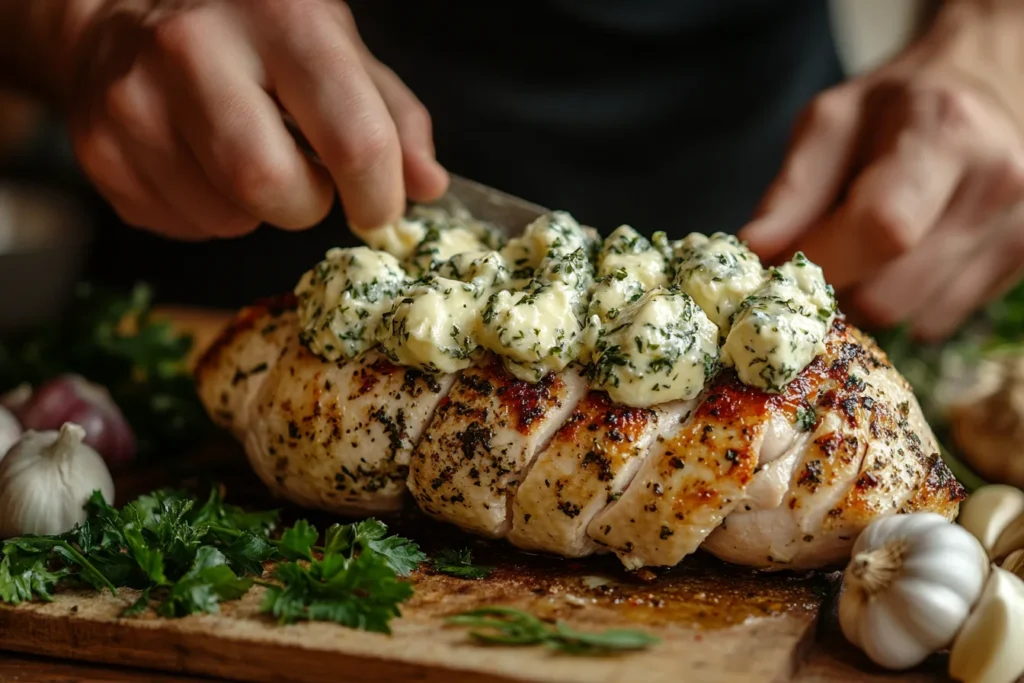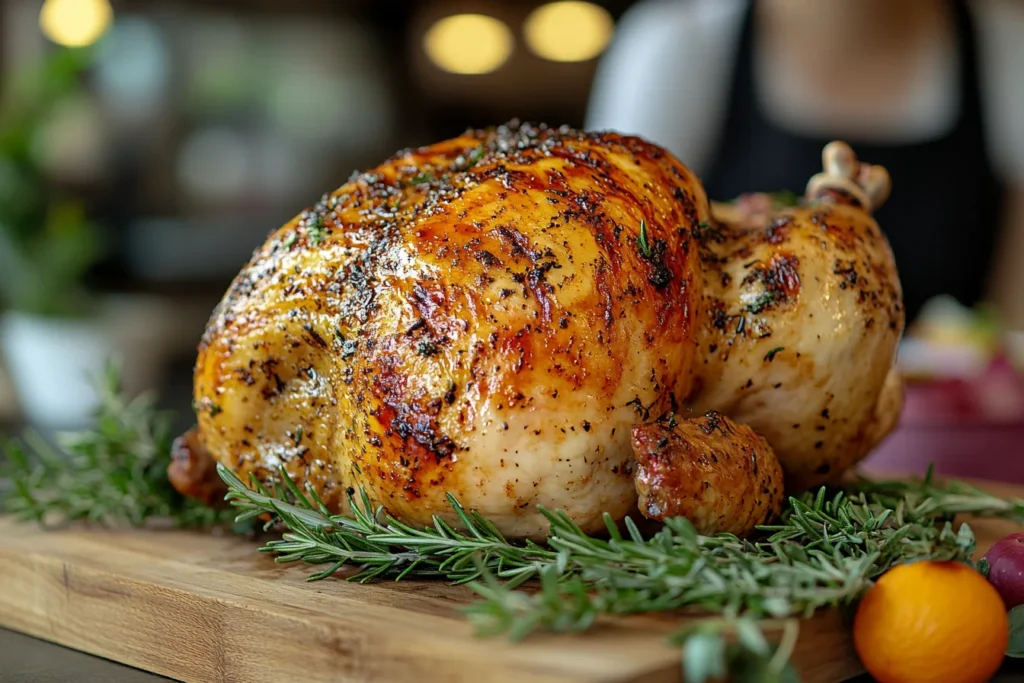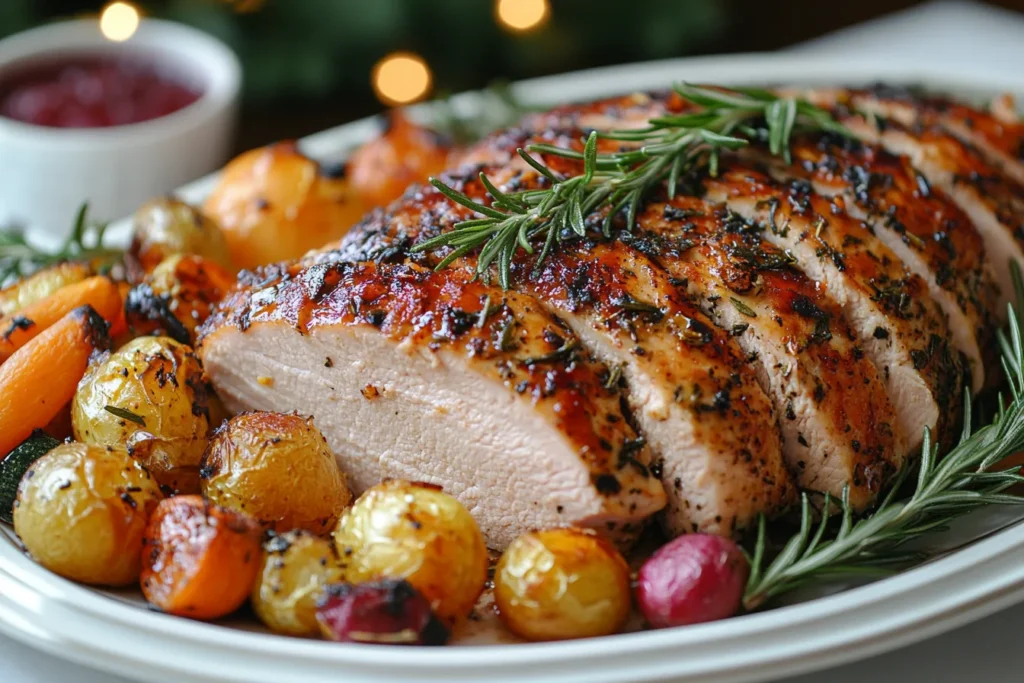Introduction to Buttering Turkey Skin
When preparing a turkey for roasting, one popular technique is putting butter under its skin. But what does putting butter under the skin of a turkey do? This method serves more than one purpose, transforming a simple turkey into a moist and flavorful centerpiece. Butter creates a barrier that locks in juices, enhances flavor, and promotes even browning. If you’re looking for a flavorful twist, check out our Creole Butter Turkey Breast Recipe, or if you’re planning your menu, explore ideas on What to Serve with Cajun Turkey Breast for the perfect pairing.
By positioning butter between the meat and skin, you create a pocket of fat that bastes the meat as it cooks. This practice is a favorite among home cooks and chefs alike because it prevents dryness a common problem with turkey breast meat. Alongside retaining moisture, the butter blends with seasonings to create a crispy, golden skin that’s irresistible.
In this article, we’ll explore the history, science, and practical tips behind buttering turkey skin. By the end, you’ll know exactly why this technique works and how to make the most of it for your holiday feast.

Table of Contents
Historical Background: Culinary Practices in Turkey Preparation
While the question “what does putting butter under the skin of a turkey do” may seem modern, similar methods have been used for centuries. Cooks have long sought ways to keep lean meats flavorful during roasting. Butter, prized for its richness and flavor, has been a staple in European kitchens since the Middle Ages.
Traditionally, larding (inserting strips of fat into meat) was a common technique to achieve tenderness. Over time, slipping butter under the skin became an easier alternative. This innovation likely gained popularity as butter became more accessible. In the U.S., roasting turkey with butter grew in popularity during the 20th century, paralleling Thanksgiving’s rise as a national holiday.
Today, the butter-under-skin method reflects a blend of historical ingenuity and modern culinary science. It’s a reminder of how age-old practices still shape the way we prepare turkey for special occasions.
The Science Behind Buttering Turkey Skin
At its core, what does putting butter under the skin of a turkey do can be answered by understanding basic cooking principles. Butter acts as both an insulator and a flavor enhancer during roasting.
- Retains Moisture:
Butter forms a protective layer under the skin, slowing the escape of moisture from the meat.
As the butter melts, it bastes the turkey from within, ensuring even hydration. - Promotes Browning:
Butter contains water and milk solids, which aid in browning. This combination results in crispy, golden skin.
The fat in butter helps heat transfer evenly, avoiding dry patches. - Enhances Flavor:
Butter infuses the meat with richness and depth.
When mixed with herbs and spices, it adds layers of seasoning directly to the turkey.
Understanding the chemistry of butter’s fats, proteins, and water reveals why this technique works so well for large poultry like turkey.
The Preparation Process
When preparing your turkey, adding butter under the skin may seem like a small step, but it has a big impact. So, what does putting butter under the skin of a turkey do during the preparation process? It sets the stage for a tender, flavorful, and visually appealing dish.
Step 1: Thawing the Turkey
Begin by fully thawing the turkey. Cooking a partially frozen bird can lead to uneven results.
Step 2: Loosening the Skin
Use your fingers to gently separate the skin from the meat without tearing it. Start at the neck and work your way down.
Take your time this is a delicate process, but it’s crucial for creating space for the butter.
Step 3: Preparing the Butter Mixture
Soften the butter and mix in your choice of seasonings, such as garlic, thyme, rosemary, or even citrus zest.
Aim for a smooth, spreadable consistency.
Step 4: Applying the Butter
Scoop small amounts of the butter mixture and press it into the pockets under the skin.
Spread it evenly over the breast and thighs for consistent coverage.
By following these steps, you ensure that the butter is evenly distributed and ready to work its magic during cooking.
Benefits of Buttering Under the Skin
When considering what does putting butter under the skin of a turkey do, the benefits are plentiful. This technique enhances the turkey’s flavor, moisture, and presentation. Let’s break down the main advantages:
- Moisture Retention
Turkey breast meat is prone to drying out, but butter creates a barrier that locks in natural juices.
As the butter melts, it continuously bastes the meat from within. - Enhanced Flavor
Butter carries the flavors of added herbs and spices directly into the meat.
The result is a well-seasoned turkey with each bite bursting with richness. - Crispy, Golden Skin
The butter helps the skin brown evenly, giving it a beautiful golden hue and a satisfyingly crispy texture. - Simplifies Basting
Instead of repeatedly opening the oven to baste the turkey, the butter under the skin does the job for you.
This helps maintain a steady cooking temperature, leading to more consistent results.
By understanding these benefits, you’ll see why this method is a game-changer for any turkey dinner.
Common Mistakes to Avoid
Even with the simplicity of this method, there are a few pitfalls to steer clear of. Knowing what does putting butter under the skin of a turkey do is only half the battle executing it properly is key to success.
- Using Too Much Butter
While it’s tempting to load up on butter, excess can cause unwanted drips and uneven cooking.
Stick to around 1/2 to 3/4 cup of butter for most turkeys. - Tearing the Skin
A torn skin allows the butter to escape and can leave parts of the turkey dry.
Work slowly and carefully when loosening the skin. - Forgetting to Season the Butter
Plain butter adds moisture but lacks depth of flavor.
Always mix in a generous amount of salt, pepper, and any herbs or spices you prefer. - Not Spreading Evenly
Concentrating the butter in one area can lead to inconsistent cooking and flavor.
Use your hands or a small spatula to distribute the butter evenly under the skin. - Skipping the Resting Period
After cooking, let the turkey rest for 20-30 minutes. Cutting too soon can cause juices to run out, leaving the meat dry.

Tips for Success
When it comes to putting butter under the skin of your turkey, following a few key tips can make a world of difference. Understanding what does putting butter under the skin of a turkey do is the first step, but perfecting the technique ensures your turkey turns out just right.
- Start with a Fully Thawed Turkey
A partially frozen turkey will cook unevenly, making it harder for the butter to do its job. Always allow enough time for a full thaw in the refrigerator about 24 hours for every 4-5 pounds of turkey. - Use High Quality Ingredients
Butter is the star of the show, so choose high-quality unsalted butter for the best results. Fresh herbs and spices are also a must for maximum flavor. - Distribute Butter Evenly
Take your time spreading the butter under the skin. Focus on covering the breast and thighs evenly to avoid dry spots or uneven seasoning. - Season Generously
Salt enhances the turkey’s natural flavor, so don’t be shy when seasoning your butter mixture. You can always mix in additional flavors like garlic, paprika, or citrus zest to customize the taste. - Let the Turkey Rest
After roasting, let the turkey rest for at least 20 minutes. This step redistributes juices throughout the meat, ensuring every bite is moist and tender.
Comparing Butter to Other Fats
When considering what does putting butter under the skin of a turkey do, you might wonder how it stacks up against other fats like oil, margarine, or even shortening. Each fat has unique properties that affect the flavor, texture, and overall outcome of your turkey. Let’s compare these options to see why butter is the gold standard.
- Butter vs. Olive Oil
Moisture Retention: Butter has a higher water content than olive oil, which helps keep the turkey moist. Olive oil lacks this property but is better for high-heat cooking due to its higher smoke point.
Flavor: Butter offers a rich, creamy flavor that enhances the turkey’s taste, while olive oil is more neutral or slightly fruity, depending on its quality.
Texture: Butter helps create a crispy, golden skin, whereas olive oil results in a less dramatic browning effect. - Butter vs. Margarine
Natural vs. Processed: Butter is a natural fat with a richer flavor, while margarine is processed and often lacks the same depth of taste.
Performance: Margarine can mimic butter’s ability to spread under the skin but may leave a greasy aftertaste. - Butter vs. Shortening
Flavor: Shortening lacks the savory notes that butter provides, offering no additional flavor to the turkey.
Texture: While shortening can create crispy skin, it doesn’t provide the same beautiful browning or natural richness.
Health Considerations
Using butter under the skin of a turkey adds moisture and flavor, but it’s important to consider the health implications of this method. While butter has its nutritional benefits, it’s also high in fat and calories, which may be a concern for some diners. Let’s take a closer look at the balance between indulgence and nutrition when using butter under the skin of your turkey.
- Nutritional Content of Butter
Butter is rich in saturated fat, which contributes to its ability to create tender, flavorful turkey meat. However, excessive saturated fat intake has been linked to heart health concerns.
On the positive side, butter contains fat-soluble vitamins like A, D, E, and K, which support various bodily functions. - Balancing Fat Intake
A moderate amount of butter (about 1/2 cup for a standard turkey) can enhance flavor without drastically increasing the fat content of your meal. Pairing the turkey with lighter sides, such as roasted vegetables or a fresh salad, helps balance the overall meal. - Alternatives for Health-Conscious Cooks
If you’re looking for a lower-fat option, consider substituting part of the butter with olive oil, which contains healthier monounsaturated fats.
Another option is blending butter with herbs, citrus, or broth to reduce the amount needed while still delivering great flavor. - Portion Control and Moderation
The butter-under-skin technique doesn’t significantly affect the turkey’s nutritional value when enjoyed in moderation. Proper portion sizes allow you to savor the rich, juicy turkey without overindulging.

Frequently Asked Questions
What does putting butter under the skin of a turkey do?
Putting butter under the skin helps keep the turkey moist, enhances flavor, and promotes even browning for a crispy, golden skin.
How much butter should I use for a turkey?
About 1/2 to 3/4 cup of softened butter is sufficient for a medium-sized turkey. Adjust based on the turkey’s size.
Can I use other fats instead of butter?
Yes, olive oil, margarine, or a butter-oil blend can be used, but butter delivers the best combination of flavor and texture.
Do I need to season the butter?
Absolutely! Mixing in herbs, spices, and even citrus zest adds extra flavor and makes the turkey more delicious.
Conclusion
So, what does putting butter below the skin of a turkey do? It transforms a easy turkey into a gentle, juicy, and flavorful centerpiece. By locking in moisture, improving taste, and assisting the pores and skin reap that coveted golden crispiness, butter performs a essential role in developing the appropriate roast turkey.
Whether you’re getting ready a vacation ceremonial dinner or a special family dinner, this approach is easy to grasp and ensures remarkable consequences. With a few thoughtful steps like seasoning the butter, lightly dispensing it beneath the pores and skin, and averting commonplace errors you can expectantly serve a turkey that’s as scrumptious because it seems.
By expertise the technique and blessings, you’ll increase your turkey game and provoke your guests every time. Butter isn’t just a cooking element it’s the name of the game to a show-preventing dish that brings every body together at the table.

